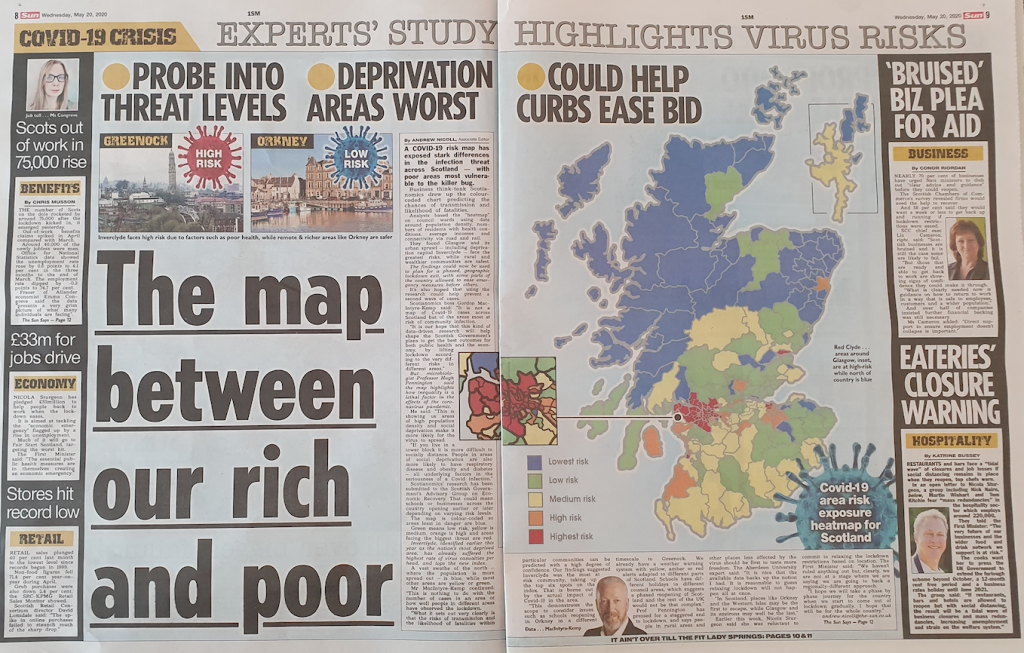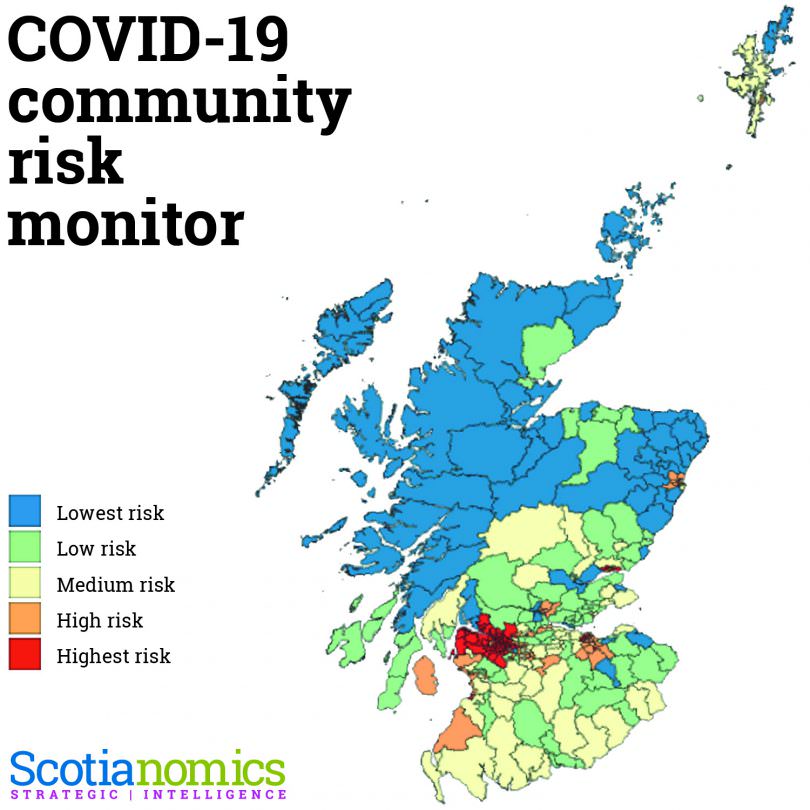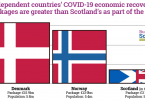A NEW Scottish think tank has published an interactive map of Scotland which shows the areas of the country which face the greatest and lowest risk of Coronavirus transmission.
A team of researchers and analysts at Scotianomics used multiple dataset sets to draw up its COVID-19 Community Risks Index, the most detailed possible picture of which Scottish communities are most under threat and this report was first presented to the Scottish Government in April. As such the data modelling correctly predicted the communities that were most at risk prior to robust transmission and fatality figures were available.
Scotianomics has produced a colour-coded map based on council constituencies – freely accessible online – which could help guide Scottish Government policy on lifting lockdown restrictions on a phased, geographic basis. That could see schools or businesses across the country open earlier or later depending on the risk levels within individual communities.
Regular readers of Business for Scotland may be familiar with the term Scotianomics as it was the name of the BfS research team and by separating out our economics/policy research and private client risk consulting from our political campaigning we hope that both will be able to deliver better results.
The public and business reaction to Coronavirus is highly-charged and often emotional. We believe this geographic breakdown can help the national response to provide clear analysis of existing data What is evident is that, for a wide variety of reasons, the risks vary hugely in different communities across Scotland. In terms of both the economy and health and well-being, we believe it makes sense to ease the lockdown according to those regional differences in risk.
There has already been a great deal of debate on whether the four nations within the UK should ease restrictions in lockstep, despite the fact that Oban is likely to have a completely different risk profile to Tower Hamlets in London. What our research shows is that there are also significant variations even within Scotland. Across the world, other countries, including China, Italy and Germany, responded to the initial threat on a regionalised basis and are now lifting lockdown according to regional variations. Our research suggests this is the most likely way to prevent a second wave and to protect the economy.
The project was led by senior researcher Samuel MacKinnon and has already been submitted to the Scottish Government’s Advisory Group on Economic Recovery and has been welcomed by Government Ministers. However, it is now being made publicly accessible and Scotianomics will update the online tracker as new datasets become available.
The data used in those calculations include population density; how many older people or those with underlying health conditions live in the area; how many people use road and rail travel; how easy or otherwise it is to access local health services; socio-economic factors, such as the average income of residents in each area.
Mr MacIntyre-Kemp added: “We want to be absolutely clear. This is nothing to do with the number of cases in an area or how well people living in each area have observed the lockdown. It is not a map of COVID-19 cases across Scotland but of the areas most at risk of community infection.
The research sets out very clearly is that the risks of transmission and the likelihood of fatalities within particular communities can be predicted with a high degree of confidence. For example, our findings suggested that Inverclyde was the most at risk community in Scotland, taking up the top six spots on the index. That has been borne out by the actual impact of COVID-19 in the area.
“This clearly demonstrates the scope to consider issues such as schools reopening on Orkney to a different timescale to Greenock. We already have a weather warning system with yellow, amber or red alerts which are adapted to different parts of Scotland. Likewise, schools have different holidays in different council areas, all of which suggest that a phased reopening of Scotland, and indeed the rest of the UK, would not be that complex.
“It is our hope that this kind of fact-based, data-driven research will help shape the Scottish Government’s plans to get the best possible outcomes for both public health and the economy, by lifting lockdown according to the very different risks in different areas.”
Scotianomics was created at the start of 2020 to offer data-driven analysis and risk assessment of significant opportunities or threats to the Scottish economy, aimed at business leaders, government policy makers and other economic decision-makers.
The Scottish Government now accepts the potential for geographical variation on their website.
We will continue to keep an open mind about the potential for geographical variation in our approach, guided by the evidence. This geographical variation could occur across the UK although, as stated in the Framework, we will only do that if the evidence and our judgement indicates that this would best meet Scotland’s particular needs and circumstances. We will continue to engage in the collective Four Nations process.
Geographical variation could also happen within Scotland. For example, future evidence may indicate that there are certain geographies where a differential approach, or different timings in the same broad approach, would be appropriate. Assessment of the right way forward would factor in broader considerations, including the scope for any geographical (or sectoral) variation to impact on the clarity of communication and broader operational considerations, for example in relation to localised testing measures and travel restrictions in the event of a geographically varied approach. And we would listen to the views of people, businesses and organisations affected by such changes. No decisions on this have been made at this stage and we will continue to keep this option under review as part of our broader review process.
Press coverage for this research so far.
 ‘NOT COMPLEX’ Scotland should have ‘phased, geographic easing of lockdown’, says think tank which ranked 354 councils by COVID risk
‘NOT COMPLEX’ Scotland should have ‘phased, geographic easing of lockdown’, says think tank which ranked 354 councils by COVID risk
Scottish Sun Online, 19/05/2020, p.1, Unattributed
The map between our rich and poor
The Sun (Scotland), 20/05/2020, p.8, Andrew Nicoll
Covid risk map ‘makes the case for easing lockdown by region’
The Herald, 20/05/2020, p.3, Helen McArdle
Covid-19: New map shows transmission risk in every Scots council ward
The National (Scotland) (Web), 19/05/2020, Unattributed
Higher-risk areas ‘should remain closed for longer’
The Times (Scotland), 20/05/2020, p.8, Mark Mclaughlin
New data reveals how coronavirus varies across Fife”s council wards
Fife Today (Web), 19/05/2020, Unattributed
Lomond North `in safest 6% of all Scottish council wards”, says virus study
The Lochside Press (Web), 19/05/2020, UnattributedThink tank draws up COVID risk map
Oban Times (Web), 19/05/2020, Unattributed
 ‘NOT COMPLEX’ Scotland should have ‘phased, geographic easing of lockdown’, says think tank which ranked 354 councils by COVID risk
‘NOT COMPLEX’ Scotland should have ‘phased, geographic easing of lockdown’, says think tank which ranked 354 councils by COVID risk






